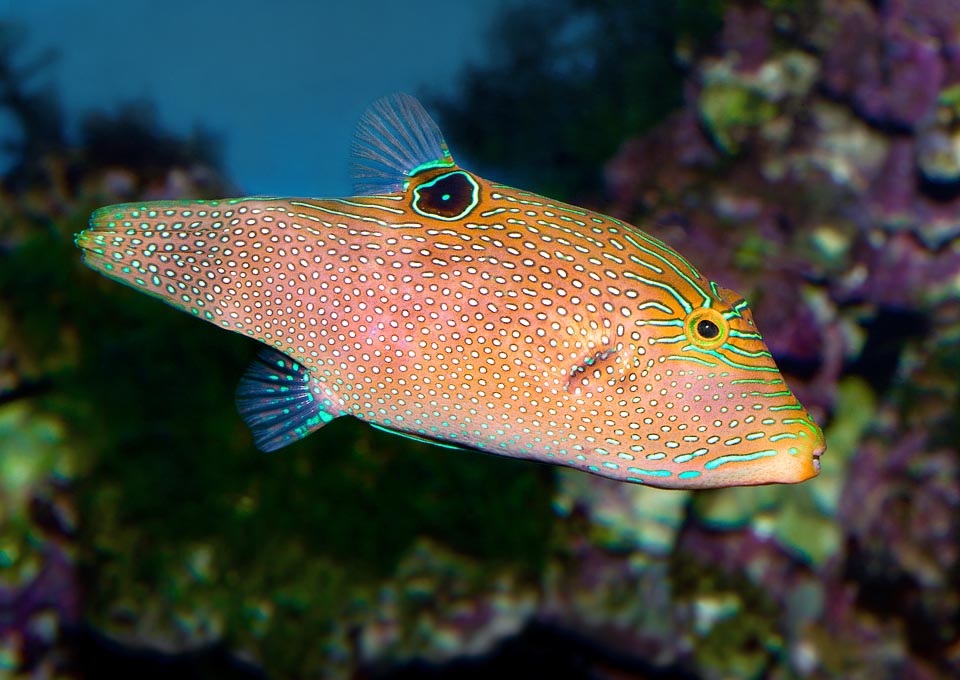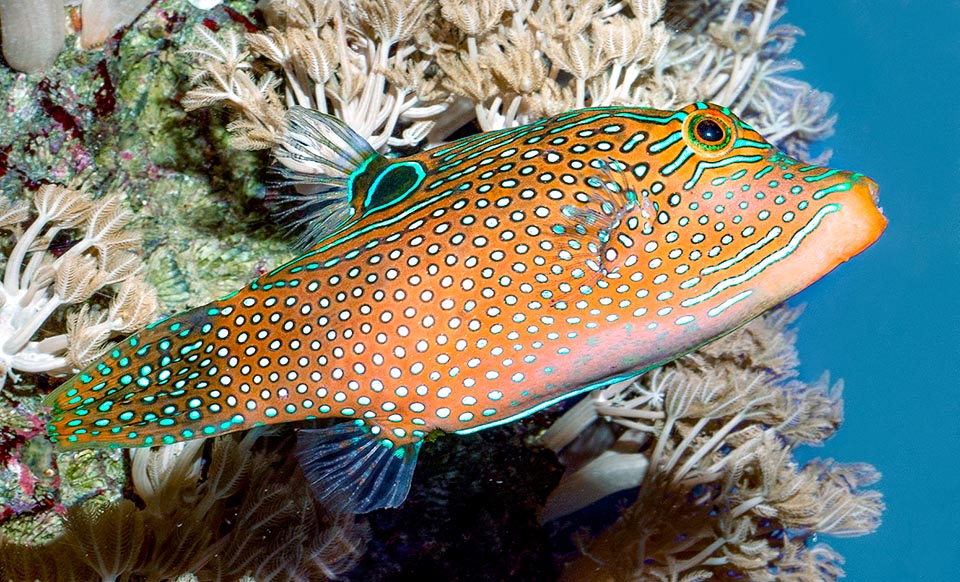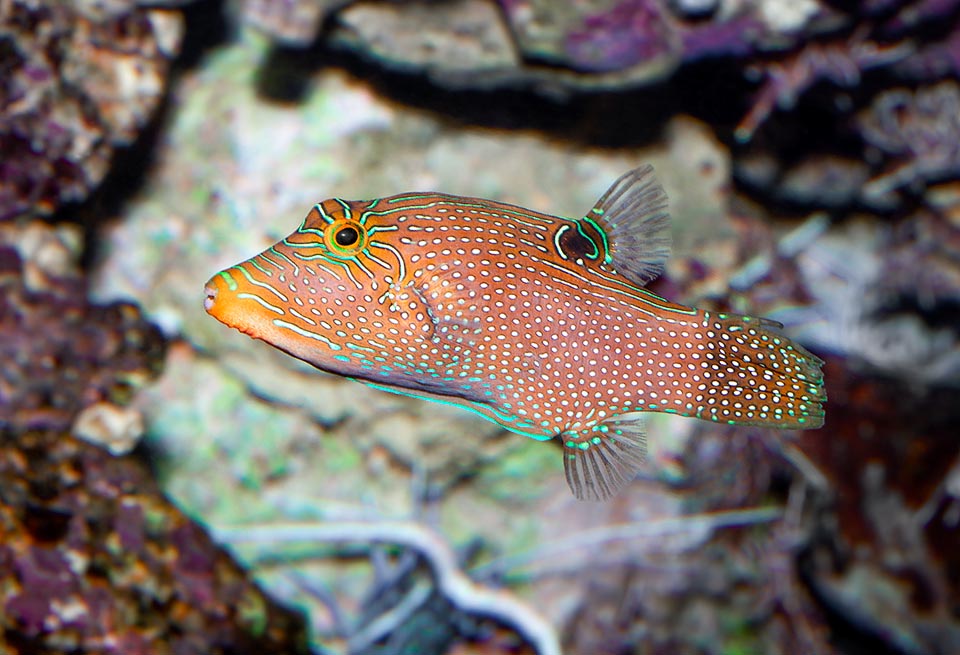Family : Tetraodontidae

Text © Giuseppe Mazza

English translation by Mario Beltramini
The Spotted sharpnose (Canthigaster solandri Richardson, 1845), belongs to the class of the Actinopterygii, the ray-finned fishes, to the order of the Tetraodontiformes and to the family of the Tetraodontidae that taxonomists have divided in two subfamilies: that of the Tetraodontinae with 25 genera and the Canthigasterinae, with only one genus, Canthigaster, which boasts however almost fourty species of the about 200 of the family.
The name of the genus Canthigaster, comes from the Greek “κανθήλια” (kanthelia), basket, and “γαστήρ” (gaster), belly, due to the possibility of inflating the belly of water, like a basket, in order to appear bigger in case of aggressions.
The species solandri recalls the Swedish Daniel Carlsson Solander, pupil of Linnaeus, who accompanied Capt. James Cook in Australia and New Zealand on-board of the Endeavour.
Taxonomically, for some scholars the species Canthigaster solandri should include also the Canthigaster papua and the Canthigaster petersii, with similar look but with different geography, and quite alike is also the Canthigaster margaritata that takes its place in the Red Sea.

Present in Oceania, the Canthigaster solandri has no scales but an armor covered by a colorful venomous skin © Giuseppe Mazza
Zoogeography
If we want to be restrictive the Canthigaster solandri is therefore a species of Oceania present from the Mariana Islands to French Polynesia, with presences, as an indication, in Micronesia, in the Marshall Islands, Caroline Islands, Salomon Islands, Wallis and Futuna and in New Caledonia.
Ecology-Habitat
It lives in relatively shallow waters, between the 10 and 36 m of depth. Rocky coasts, lagoons, and both sides of the reefs.
Morphophysiology
It is a small fish, of oval and squat shape, that is just over the 10 cm. It displays the typical structure of the trunkfishes: no scales and an underskin armour equipped with small openings at the eyes, the mouth, fins, gills and anus. The muzzle, elongated, narrows in a funnel towards the mouth, placed in advanced position with the characteristic beak of the Tetraodontiformes formed by the two incisors per jaw.

The males, bigger than the females, display less thick speckling but with polka dots of bigger diameter © Giuseppe Mazza
The body and the caudal fin have a reddish background colour, fading to orange towards the mouth, dotted by dense light punctuations with more or less turquoise shades such as the bands straddling the muzzle and close to the eyes that we find again more or less fragmented on the back and starting from the mouth to the belly. The males, bigger, show a less thick punctuation but with polka dots having a larger diametre.
Typical is, anyway, the dark ocellus at the base of the dorsal fin encircled by a turquoise stroke, often almost fluorescent like the possible small dot at the centre. A fake eye to confuse ideas to the predators that adds, on the defensive level, to the capacity of inflating the belly of water, like a balloon, to astonish and not to be seized, and at the presence in the skin and in various organs of the tetrodotoxin, the powerful venom of the balloonfishes developped by symbiotic bacteria such as the Pseudoalteromonas tetraodonis and associated to colourful liveries to warn the intruders.
The caudal fin is often kept closed, like a balance wheel, when the fish is sailing quietly using the undulations of the dorsal fin and of the anal one, but when necessary it can give a significant boost to the flee.

It mainly nourishes of filamentous algae but also of polyps of madrepores, sponges, ascidia, echinoderms, molluscs and small worms © Giuseppe Mazza
Ethology-Reproductive Biology
The Canthigaster solandri is omnivorous. It cares the reefs nourishing mainly of the filamentous algae infesting the corals, except when, without too many scruples, it eats their polyps and nibbles sponges, ascidia or echinoderms. Finally, it eats all what it finds without making too much effort, including the small crustaceans, the molluscs or the tasty little worms that fall in its dish.
It is a species living in pairs or in small groups. The males, very territorial during the reproductive period, at times have a small harem. The spawning takes place in nests improvised by the female between the algae. The eggs, immediately fecundated, will hatch after a few days. Resilience is good, with populations that can double in less than 15 months, and the fishing vulnerability index , very low, marks just 10 on a scale of 100.
Since 2011 Canthigaster solandri has therefore been listed as “LC, Least Concern” in the IUCN Red List of endangered species.
Synonyms
Canthigaster australis Stead, 1907; Canthigaster glaucospilotus Fowler, 1944; Canthigaster saipanensis Fowler, 1945.
→ For general information about FISH please click here.
→ For general information about BONY FISH please click here
→ For general information about CARTILAGINOUS FISH please click here.
→ To appreciate the BIODIVERSITY of BONY FISH please click here.
→ To appreciate the BIODIVERSITY of CARTILAGINOUS FISH please click here.
